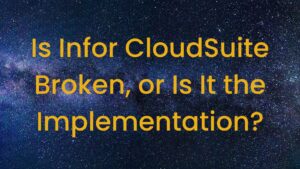ERP implementations are never easy—but for small businesses, they can be uniquely challenging. With fewer resources, tighter margins, and more hands-on leadership, small organizations must rely heavily on strong executive sponsorship to ensure digital transformation success.
Whether you’re replacing outdated systems or rolling out new technology, the role of leadership—and more specifically, the executive sponsor—is essential. This blog breaks down what makes executive involvement different in small businesses, common missteps to avoid, and how to build the internal alignment needed to make your ERP project succeed.
Table of Contents
ToggleWhy Executive Sponsorship Matters—No Matter the Company Size
Some assume that large enterprises need strong executive sponsors, but small businesses can “wing it.” That couldn’t be further from the truth.
According to Third Stage Consulting, regardless of size, executive sponsorship is one of the most critical success factors in ERP and digital transformation projects.
Jordan, a transformation consultant at Third Stage, puts it simply:
“No matter what size business you’re working with, having executive presence to communicate the why behind the change is crucial.”
This includes:
- Articulating the strategic vision behind the transformation
- Communicating the benefits and business case to the team
- Reinforcing that change won’t be easy—but it’s necessary
In smaller companies, the leadership team is often more visible and hands-on, which can be an advantage—but also a risk if they don’t show full commitment.
The Second Layer: Mid-Level Leaders Drive Execution
While executive vision sets the tone, it’s the second layer down—department heads, operations leads, and frontline managers—that carries out the vision.
Nate, another transformation leader at Third Stage, calls this the “chain of command”:
“Executive sponsorship is a must—but it’s that second level down that keeps departments focused. They’re the ones aligning the troops and ensuring consistency in execution.”
In small businesses, where departments are lean and teams wear multiple hats, this layer becomes even more influential. Without clarity, empowerment, and alignment from these mid-level leaders, the project will stall—regardless of how visionary the CEO is.
Founder-Led Businesses: A Unique Opportunity and Risk
Many small businesses are still run by their original founders. These individuals often have:
- Deep institutional knowledge
- Long-standing loyalty from the team
- A strong personal connection to the business vision
But founder-led businesses also come with risk. If the founder is disengaged from the ERP project—or becomes a bottleneck in decision-making—it can undermine momentum and cause confusion.
That’s why it’s critical that founders:
- Serve as the visible face of change
- Publicly endorse the project and its goals
- Empower others to make key decisions—even if they aren’t involved in every detail
Want to see what strong leadership looks like in a transformation setting? Explore our digital transformation strategies here.
Don’t Overlook the Front Line
While executives and managers drive strategy, it’s the end users—the people doing the work daily—who must execute the change.
A comment from Matt on LinkedIn summarized it perfectly:
“The key to success is the change readiness of the team on the floor—not just the readiness of execs driving the implementation.”
Involve these users early. Ask them about:
- Pain points in the current system
- What they need to do their jobs more effectively
- How they prefer to learn and adapt to new tools
You’ll gain faster adoption, better process improvement ideas, and fewer surprises later on.
Common Mistakes Small Businesses Make (and How to Avoid Them)
Darian on LinkedIn asked: “What are the most common missteps small businesses make during this transition?”
Here are the top three:
1. Lack of Executive Visioning
“If you don’t start with executive visioning, you’re already off track.” – Nate
Start every ERP or digital transformation project—no matter how small—with a formal vision session. This can take a few hours or a few days depending on your size, but the output should define:
- Where the organization is today
- Where you want to go
- How technology will get you there
- What success looks like in 6–12 months
2. Poor Communication of the Why
If your team doesn’t understand why the system is changing, they’ll default to resistance.
Set the tone early by answering:
- Why are we investing in this?
- How will it make our jobs easier or more impactful?
- What changes are coming, and when?
Use multiple channels—email, town halls, team meetings—to ensure the message is heard and repeated often.
3. Unclear Roles and Decision-Making
When people don’t know who’s in charge of what, they stop making decisions—or duplicate effort.
Avoid this by:
- Defining your project governance early
- Clarifying who owns decisions
- Empowering mid-level leaders and team leads
Small businesses can move quickly, but only with clear leadership, defined roles, and active sponsorship from the top.
Final Thoughts: Leadership Drives Change, Not Technology
At the end of the day, ERP software is just a tool. What determines success is your leadership, alignment, and communication.
Whether you’re a 30-person manufacturer or a 150-person services firm, your ERP project will succeed or fail based on:
- Executive engagement
- Mid-level empowerment
- Frontline readiness
Want help building the right foundation? Contact Third Stage Consulting for guidance on ERP readiness assessments, software selection, and digital strategy tailored to small businesses.
🎥 Watch More Executive Sponsorship Tips on YouTube
Prefer to learn through video? Subscribe to Third Stage on YouTube for expert breakdowns of ERP strategy, leadership pitfalls, and real-world transformation lessons.






